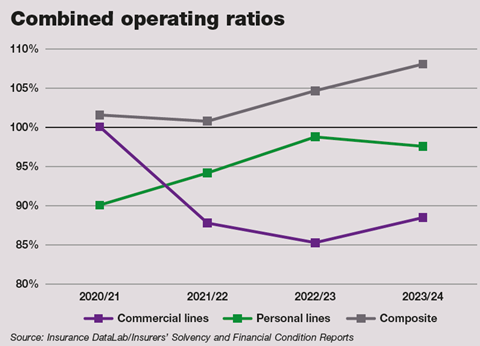Insurance DataLab looks at how commercial, personal and composite insurers have performed
Specialist insurers continue to outperform their more generalist peers, with composite insurers falling to an aggregate underwriting loss for the fourth consecutive year. Both personal and commercial lines insurers, meanwhile, reported aggregate underwriting profits for 2023/24.

Those are the findings of an exclusive analysis of insurer Solvency and Financial Condition Reports (SFCRs) by market intelligence firm Insurance DataLab.
This analysis revealed that composite insurers across the UK and Gibraltarian markets reported an aggregate combined operating ratio (COR) of 108.1%.
This is some 3.4 percentage points higher than the 104.7% aggregate ratio for 2022/23 and means that insurers which sell both personal and commercial lines policies have now fallen to an aggregate underwriting loss in every year of this analysis, which started in the 2020/21 financial year.
This poor performance has been driven by a high loss ratio, which has risen in each of the past two years and has been comfortably higher than the loss ratio for their personal and commercial lines peers in each of the last four years.
Composite insurers reported an aggregate loss ratio of 72.3% for 2023/24, 4.6 percentage points worse than in 2022/23 and the worst loss ratio for any cohort of insurers over the past four years.
The impact of this worsening claims performance was, however, partially offset by an improving expense ratio of 35.8% for 2023/24, which is 1.3 percentage points better than the previous year.
Personal lines improving
Personal lines insurers, meanwhile, have experienced an upturn in performance, reporting an aggregate COR of 97.6% for 2023/24, a 1.2 percentage point improvement on the 98.8% ratio reported for 2022/23.

This is despite a 3.4 percentage point increase in the aggregate personal lines loss ratio, which rose to 66%. But the rate of increase in the loss ratio has been slowing – no doubt aided by the increase in premiums that has been seen across much of the personal lines market – with the aggregate loss ratio growing by some 6.5 percentage points between 2021/22 and 2022/23.
This improvement in the personal lines underwriting performance has been driven by an improving expense ratio that fell by 4.5 percentage points to 31.6% for 2023/24.
This is the lowest aggregate expense ratio of the three cohorts of insurers that make up this analysis and marks the third consecutive year that personal lines insurers have improved this measure.
Commercial takes a lead
But it is commercial lines insurers that are leading the way on underwriting performance, after reporting a highly profitable aggregate COR of 88.5% for 2023/24.
Indeed, this marks the third consecutive year for which commercial lines specialists have reported a profitable aggregate COR, after falling to an underwriting loss in 2020/21 with a COR of 100.1%.
It is also the third straight year that commercial lines insurers have reported a sub-90% COR.
This strong performance has been driven by a market-leading loss ratio across each of the past three years, with commercial lines insurers reporting an aggregate loss ratio of 50.5% for 2023/24.
While this represents a 1.1 percentage point increase on the previous year, it is still some 15.5 percentage points better than the specialist personal lines market and 21.8 percentage points better than composite insurers.
Expense performance in the commercial lines market has suffered, however, with the aggregate expense ratio rising by two percentage points to 38%.
This is higher than the expense ratio reported by both personal lines specialists and composite insurers – and commercial lines was the only area of the market to report a worsening performance of this measure.
Despite this rising expense ratio, commercial lines insurers are still performing better than in 2020/21, when the aggregate commercial lines expense ratio stood at 40.8%.

And while commercial lines insurers face a higher expense base compared with their personal lines peers, the sustained strength of their loss ratio suggests they are well positioned to maintain their lead.
If they can manage to bring their expenses down even slightly, they could further solidify their dominance in the coming years.
In contrast, composite insurers continue to struggle – and without decisive action to address their deteriorating loss ratios, they risk remaining adrift of the pack.
While the improving COR performance of personal lines insurers adds a positive note, it is clear that the commercial lines sector remains the benchmark for profitability.

















































No comments yet